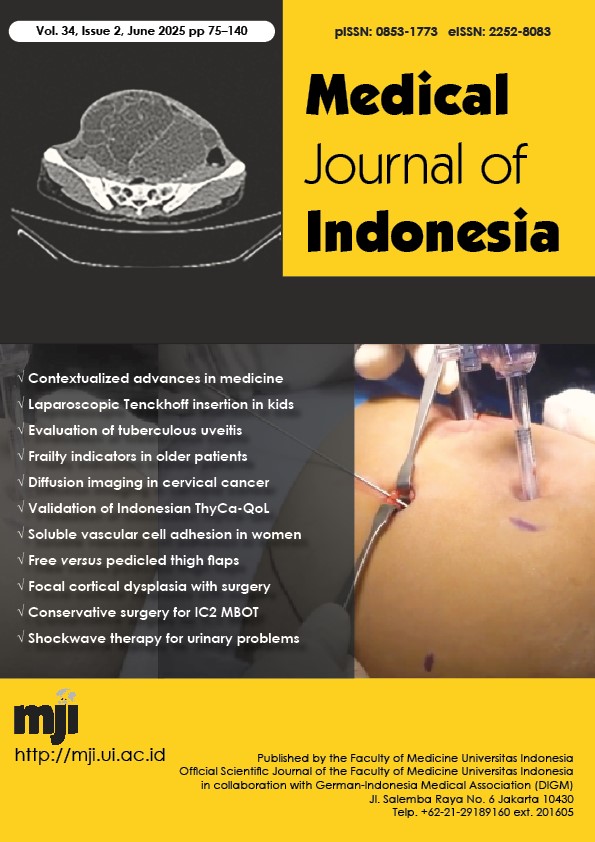Laparoscopic Tenckhoff catheter insertion technique with Alken telescopic metal dilator in pediatric population
DOI:
https://doi.org/10.13181/mji.oa.257670Keywords:
end-stage renal disease, laparoscopy, pediatrics, peritoneal dialysis, surgical proceduresAbstract
BACKGROUND End-stage renal disease (ESRD) is a major public health concern worldwide, with peritoneal dialysis (PD) offering a key alternative to hemodialysis. Flow restriction due to catheter migration is a common complication, affecting 7–26% of patients with PD. This study aimed to reduce complications in pediatric patients by examining a novel laparoscopic Tenckhoff catheter insertion technique using an Alken telescopic metal dilator.
METHODS In a prospective observational study conducted between September 2018 and October 2022, 33 pediatric patients with ESRD underwent laparoscopic Tenckhoff catheter insertion using a combination of laparoscopic and Seldinger techniques with Alken dilators. This approach involves rectus sheath tunneling using a nephrostomy puncture needle, wire insertion, and dilatation of up to 15 Fr using Alken telescopic metal dilators under laparoscopic guidance. Survival analysis was used to assess catheter survival and complication rates.
RESULTS The mean (standard deviation [SD]) patient age was 11.92 (3.7) years, with a median follow-up of 21.3 months. Catheter survival was 84.8%, with 5 catheter withdrawals due to infections (4 cases) or obstruction (1 case). Early and late complications, including exit-site infection, peritonitis, and catheter obstruction, occurred annually at rates of 0.10, 0.03, and 0.02 episodes per patient, respectively. No pericatheter leakage occurred.
CONCLUSIONS This novel laparoscopic Tenckhoff catheter insertion technique using an Alken telescopic metal dilator become a simple and minimally invasive method, and associated with high catheter survival and low complication rates. Therefore, further comparative studies are recommended.
Downloads
References
Masalskienė J, Rudaitis Š, Vitkevič R, Čerkauskienė R, Dobilienė D, Jankauskienė A. Epidemiology of chronic kidney disease in children: a report from Lithuania. Medicina (Kaunas). 2021;57(2):112. https://doi.org/10.3390/medicina57020112
Pardede SO, Rafli A, Gunardi H. Quality of life in chronic kidney disease children using assessment Pediatric Quality Of Life Inventory™. Saudi J Kidney Dis Transpl. 2019;30(4):812−8. https://doi.org/10.4103/1319-2442.265456
Nourse P, Cullis B, Finkelstein F, Numanoglu A, Warady B, Antwi S, et al. ISPD guidelines for peritoneal dialysis in acute kidney injury: 2020 update (paediatrics). Perit Dial Int. 2021;41(2):139-57. https://doi.org/10.1177/0896860820982120
Hernández-Castillo JL, Balderas-Juárez J, Jiménez-Zarazúa O, Guerrero-Toriz K, Loeza-Uribe MP, Tenorio-Aguirre EK, et al. Factors associated with urgent-start peritoneal dialysis catheter complications in ESRD. Kidney Int Rep. 2020;5(10):1722-8. https://doi.org/10.1016/j.ekir.2020.07.025
La Plant MB, Saltzman DA, Segura BJ, Acton RD, Feltis BA, Hess DJ. Peritoneal dialysis catheter placement, outcomes, and complications. Pediatr Surg Int. 2018;34(11):1239-44. https://doi.org/10.1007/s00383-018-4342-1
Bircan HY, Kulah E. Effects of a novel peritoneal dialysis: the open versus laparoscopic preperitoneal tunneling technique. Ther Apher Dial. 2016;20(1):66−72. https://doi.org/10.1111/1744-9987.12377
Blitzkow AC, Biagini G, Sabbag CA, Buffara-Junior VA. Laparascopic peritoneal dialysis catheter placement with rectus sheath tunneling: a one-port simplified technique. Arq Bras Cir Dig. 2022;35:e1690. https://doi.org/10.1590/0102-672020220002e1690
Krezalek MA, Bonamici N, Lapin B, Carbray J, Velasco J, Denham W, et al. Laparoscopic peritoneal dialysis catheter insertion using rectus sheath tunnel and selective omentopexy significantly reduces catheter dysfunction and increases peritoneal dialysis longevity. Surgery. 2016;160(4):924-35. https://doi.org/10.1016/j.surg.2016.06.005
Pourhoseingholi MA, Vahedi M, Rahimzadeh M. Sample size calculation in medical studies. Gastroenterol Hepatol Bed Bench. 2013;6(1):14−7.
Lim CY, Oo AP, Rajput AS, Daiwajna RG, Lim YY, Tan J. A nationwide comparative analysis of peritoneoscopic and laparoscopic techniques for peritoneal dialysis catheter insertion in Brunei Darussalam. Kidney360. 2023;4(2):198−205. https://doi.org/10.34067/KID.0006052022
Yu Y, Xie Q, Chen Y, Hu W, Zhang P, Huang S, et al. Ultrasoundguided modified seldinger placement of Tenckhoff catheters in pediatric patients undergoing peritoneal dialysis: single center experience. Front Pediatr. 2022;10:917720. https://doi.org/10.3389/fped.2022.917720
Lee CY, Tsai MK, Chen YT, Zhan YJ, Wang ML, Chen CC. Importance of the creation of a short musculofascial tunnel in peritoneal dialysis catheter placement. World J Clin Cases. 2022;10(4):1182-9. https://doi.org/10.12998/wjcc.v10.i4.1182
Salgaonkar HP, Behera RR, Sharma PC, Katara A, Bhandarkar DS. Minimally invasive surgery for salvage of malfunctioning peritoneal dialysis catheters. J Minim Access Surg. 2019;15(1):19-24. https://doi.org/10.4103/jmas.JMAS_184_17
Hagen SM, Lafranca JA, Steyerberg EW, IJzermans JN, Dor FJ. Laparoscopic versus open peritoneal dialysis catheter insertion: a meta-analysis. PLoS One. 2013;8(2):e56351. https://doi.org/10.1371/journal.pone.0056351
Abdijalil G, Shuijuan S. Laparoscopic versus open surgery catheter placement in peritoneal dialysis patients: a metaanalysis of outcomes. Indian J Nephrol. 2022;32(5):406−13. https://doi.org/10.4103/ijn.IJN_468_20
Zhang X, Xiang S, Wang Y, Liu G, Xie X, Han F, et al. Laparoscopic vs open surgical insertion of peritoneal dialysis catheters: a propensity score-matched cohort study. Curr Probl Surg. 2024;61(1):101425. https://doi.org/10.1016/j.cpsurg.2023.101425
Baksi A, Asuri K, Vuthaluru S, Yadav RK, Prajapati OP, Bansal VK, et al. Does laparoscopic omentectomy reduce CAPD catheter malfunction: a three-arm pilot randomized trial. Indian J Nephrol. 2022;32(4):299-306. https://doi.org/10.4103/ijn.ijn_168_21
Keswani M, Redpath Mahon AC, Richardson T, Rodean J, Couloures O, Martin A, et al. Risk factors for early onset peritonitis: the SCOPE collaborative. Pediatr Nephrol. 2019;34(8):1387-94. https://doi.org/10.1007/s00467-019-04248-0
Bıçakçı Ü, Genç G, Tander B, Günaydın M, Demirel D, Özkaya O, et al. Single port laparoscopic and open surgical accesses of chronic peritoneal dialysis in children: a single center experience over 12 years. J Minim Access Surg. 2016;12(2):162-6. https://doi.org/10.4103/0972-9941.147364
Published
How to Cite
Issue
Section
License
Copyright (c) 2025 Gerhard Reinaldi Situmorang, Fekhaza Alfarissi, Putu Angga Risky Raharja, Arry Rodjani, Irfan Wahyudi

This work is licensed under a Creative Commons Attribution-NonCommercial 4.0 International License.
Authors who publish with Medical Journal of Indonesia agree to the following terms:
- Authors retain copyright and grant Medical Journal of Indonesia right of first publication with the work simultaneously licensed under a Creative Commons Attribution-NonCommercial License that allows others to remix, adapt, build upon the work non-commercially with an acknowledgment of the work’s authorship and initial publication in Medical Journal of Indonesia.
- Authors are permitted to copy and redistribute the journal's published version of the work non-commercially (e.g., post it to an institutional repository or publish it in a book), with an acknowledgment of its initial publication in Medical Journal of Indonesia.






































